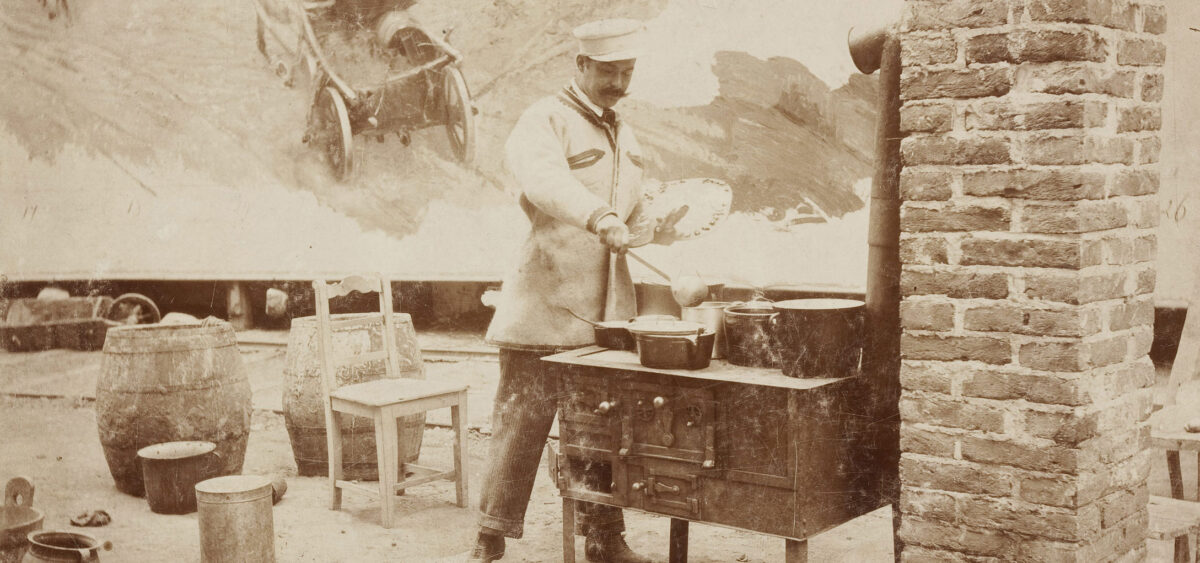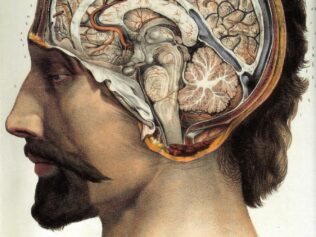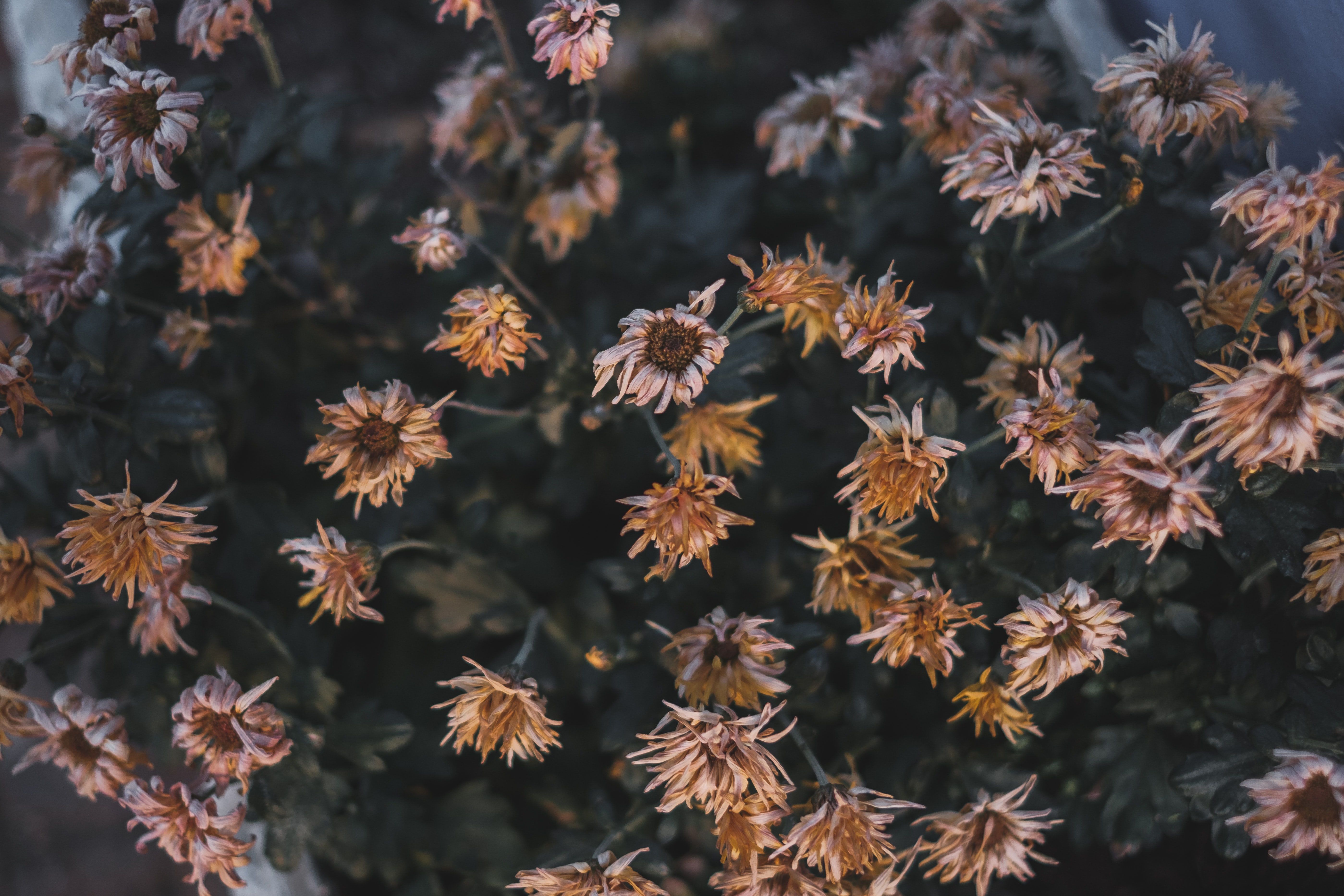
Believe it or not, I recently found a book containing a recipe for primordial broth—the same that supposedly started life on Earth.
It was a lazy Sunday. The sun was pouring in through the curtains and streams of light dispersed across dust particles resembling milky lint. Cigarette smoke hung in the air, sharing my leisurely mood. I left the stock on low heat, marinated the tofu, and went out for a walk.
I was pondering over the meaning of it all. Just as I was about to grasp the solution to this mystery, reaching out with the finger of my imagination to the intersection where all vectors of causality meet, atoms of truth supposedly crystallizing into the ultimate fractal of being, I tripped and fell. Annoyed, I got up, brushed the dust off my knees and noticed out of the corner of my eye a strange shape protruding from below the offending tree root—the real perpetrator of this attempt on my life. It turned out to be a book, its spine inscribed with symbols I could not understand.
A bird started from the tree and as I placed my eyes again on the tome, the symbols arranged themselves into legible words: “Tohu va-Vohu presents ways of organizing matter into life.”
Leafing through the volume, I discovered it was full of chemical formulas, mathematical equations, and biological schemata interlaced with text. I threw the book into my backpack and headed to the friend whom I usually consult on occult and scientific matters. He did not fail me. What follows is a summary of what I learned from the book, so that you too, can try to create life at home.
In the Lipid House
The introduction read:
“Are you a primordial deity, but your existence feels incomplete? Are you tired of thought experiments and clay figurines? Do you dream of organic toys that do not have to be wound up? Do you feel like you could use some form of cult worship? This book is for you! Just remember that the process is difficult to stop; once out of the bottle, life is hard to eradicate.
In order to create life, you need to first understand what it is. There are plenty of definitions. Its most important features include the capability to replicate, metabolize, and evolve. The forms of life that most readily embrace religion are cellular in structure. A body with a brain capable of faith is highly complex and many deities fail trying to build it from scratch. The best way is to cook up single-cell life and give it several billion years to evolve. As we say among ourselves, the seventh day is for resting!
Before using any recipe, please consult the ‘Cell Characteristics’ section of the manual. Alternatively, you may consult an oracle or an alchemist, because any life that is improperly cooked may be harmful to your existence or mental health.”
The first passage read:
“Cellular structure separates the interior of the living being from the environment. Thanks to this, its insides do not spill out into the soup. If they did, all would go to hell, because the building blocks would dissolve in the broth and never reorganize themselves properly. After all, life is about keeping order.
You need a cellular membrane that will serve as packaging. From my own experience I know that a double lipid layer works just fine. Lipids are made of a water-loving head and a water-hating tail. Because of this, in aqueous solutions they assume a specific position, with tails protecting themselves from the water and heads forming membrane walls. Such pairs arrange themselves side-by-side until they form a layer that then folds into a ball, its center tightly secured from the outside and holding the cell’s belly. This is how cells acquire their shape.”
The second passage read:
“For life to function, multiply, and transmit knowledge to offspring, a storage device becomes indispensable. Unfortunately, a simple USB stick does not suffice because it cannot store enough data and will be invented only much later. However, nucleic acids like DNA and RNA are a great carrier of information.
Life is largely built from polymers, or long chains of little blocks of acid glued together, known as nucleotides. It only takes eight of them to form DNA and RNA. The instructions necessary to produce all the elements of life are contained in the sequences of these eight pieces. This is how cells record knowledge.”
The third passage read:
“A key role in cell operation is played by proteins—they are the material, the product, the worker, and the machine at the cellular factory. Some of them have structural functions and can be likened to scaffolding, giving the cell its shape and helping it to move and divide.
Cells also contain transport proteins whose task is to move things around. This is highly important because it is hard to imagine efficient operation at a factory where materials and products are lying around scattered, while machines and walls are placed at random.
Enzymes are also proteins that conduct, accelerate, and supervise chemical reactions. Like a trained craftsman who has perfected few actions but performs them quickly and precisely, they organize themselves into enzymatic pathways and regulate the cell’s metabolism. If you give a sugar particle to one of them, it will work its magic and pass it on to another worker who knows different spells. After several steps, the enzymatic pathway produces water, carbon dioxide, and valuable energy. It can also assemble individual pieces into more complex structures.
There are many more roles played by proteins. They control the copying, interpreting, and amending of information contained in nucleic acids. They are sensors, transmitters, and effectors.
Every protein is a polymer made of amino acids. It takes twenty of them to build life. Their sequence in the protein chain is recorded in the DNA, which is translated into RNA. On this basis, proteins are made. In this way, cells organize themselves, read the instructions they contain within, explore their surroundings, and nourish themselves.”
The fourth passage read:
“The one feature of living cells that is necessary if you wish to have devoted followers is the capacity for evolution. In the short run, organisms can adapt to changing conditions, but these alterations are not necessarily passed on to the offspring. What defines real adaptation is genetic variation. When the cell splits, its genetic material is replicated and distributed equally among the offspring. In theory, this process could go on indefinitely, the children being faithful copies of the mother. However, life would then be unable to adapt to the changing environment.
Luckily, the protein co-workers sometimes make mistakes. Occasionally, the copied DNA differs from the original by several letters, leading to the creation of slightly different proteins. A mutated worker usually performs equally well or worse than the original (sometimes not working at all), but occasionally it proves to be more efficient. A cell that employs the mutant will be better adapted, its being-in-the-world becoming more resourceful. Along with changes in the environment, which exert pressure on living beings, worse-adapted cells will die, while those with favorable mutations will thrive. Generation after generation, change after change, mutation after mutation, cells acquire new skills. This is how simple forms evolve into more and more complex ones.
Now you know what life is and what form it is best to give it to avoid overworking yourself. You also understand that cells are built of numerous polymers ordered according to their role. Composed of amino acids, proteins transmit and perform orders, creating metabolic pathways that conduct alchemical transmutations of matter and energy. Built from sugar and several additives, DNA and RNA form the genetic code—an instruction manual that allows the organism to build every element of the cell. All of this is enclosed in a bubble of fat that separates the cell’s inside from the outside world. This may seem complicated, but don’t worry. The entire system is self-sufficient, and if you exert the right pressure, evolution will do most of the work.
In your anthropomorphic head some questions may arise: How am I to produce all these complex components? Where am I to find the right building blocks? All I have at my disposal is a sterile planet showered in a fiery rain of meteorites and shrouded in a toxic atmosphere full of cyanide, carbon dioxide, and eye-irritating sulfates. Such doubts are often experienced; no need to panic. Below you’ll find a plethora of recipes for bringing dead matter to life.”

Onions, Eggs, and a Potato
The first recipe was titled “Primordial Sandwich” and seemed very promising. The “Iron and Sulfur Goulash” intrigued in more than one way, while “Homemade Silicon Crystals” carried the promise of lifeforms that Earthlings could never imagine. However, my friend and I focused on the soup because we both adore this dish. There was a list of ingredients and equipment. Diagrams showing vessels linked with pipes, burners, UV lamps, and current generators formed a truly alchemical image. The text itself was spare yet clearly sufficient for the initiated. The first of three steps was termed “Monomerizing.” It read: “Pour water into the pot and place on a fire. Pump methane, hydrogen, and ammonia inside, then electrify the mixture. Alternate between chilling and warming the soup.”
Asked about the purpose of these procedures, my friend recalled the classic experiment by Miller-Urey. In 1953, an attempt was made to synthesize basic organic compounds in laboratory conditions from gasses that could have been present in Earth’s early atmosphere. Methane is a source of carbon, ammonia brings nitrogen, water is the medium for the reaction and a source of oxygen, while hydrogen is a reducing agent that greatly increases the efficiency of creating organic compounds. Mixing, thinning, and thickening the soup are performed by raising and lowering the temperature. Reactions are powered by electric discharges. The conditions of the experiment can be modified. Since it was widely available on the surface of early Earth, UV radiation can be used instead of electricity. Carbon can be obtained from carbon monoxide or dioxide, while ammonia can be replaced with pure nitrogen. There are plenty of options. Importantly, after some time the pot is going to be full of simple organic compounds. Some of them will be monomers that are ready to use as building blocks, but others may only be in their early form.
The recipe continues: “Put grated roasted almonds and chopped onion into a pot. Instead of the latter you can use eggs, but remember not to spend too much time deciding what to add first. Warm and cool the soup to your liking.”
My friend gave a hearty laugh and explained that this is a highly elaborate metaphor describing chemistry based on cyanide and sulfur. In the very first step, hydrogen cyanide will be produced, from which a whole gamut of life-giving compounds can be formed, but the author clearly recommends increasing its concentration by adding almonds. Onions and eggs, on the other hand, are a source of sulfur. As experiments conducted in John Sutherland’s laboratory have shown, by combining the products from the previous stage with cyanide and sulfur, it is possible to synthesize most of the amino acids, simple lipids, and nucleotides needed for life, which are more than eager to form greater wholes. There’s no need to be worried about the toxicity of cyanide, because it harms only oxygen-based organisms, which will appear on the planet much later.
At the end of the first step there was another instruction: “Add a potato. Everything clings to the potato.”
It sounded like a joke to me, but for my friend it was cause for thought. When questioned, he explained that he was wondering how he could clarify such a complex matter. As it turns out, this concerns stereoisomerism. In biology, most building blocks appear in two forms that differ in spatial arrangement. Just like human hands are a mirror image of each other, chemical molecules have two possible versions; in the soup, the same amount of right- and left-forms should appear. The problem is that living organisms use left-form amino acids and right-form sugars. How does one get the soup to produce exactly these versions? The answer is the potato, which plays the role of a porous surface on which newly-formed molecules can land (the primordial soup was simmered among rough rocks). A mixture of left- and right-forms crystallize on the surface of the potato as the soup evaporates. Left- and right-forms cling to their own kind, but when water is added, some of the crystals dissolve, thus disturbing the balance. Thanks to this, one of the forms will prevail, dominating the mixture after some time. To illustrate this phenomenon, my friend recalled analyses of asteroids, which were found to contain amino acids and sugars that were not characterized by stereoisomeric balance, one form dominating the other. I would have never thought that a potato could mean so much. As it turns out, after the first stage the soup already contains enough elements to assemble a living organism.
There was also a handwritten note on the margin: “Throw in something from a distance: an allspice berry from the dusty floor, a dry pepper grain, or even a speck of dirt from the spider’s web in the corner of the room. If you score, say the name of your favorite basketball player.”
I assumed that this remark wasn’t crucial, but my friend was intrigued. As it turns out, the surface of the planet has always been showered with large amounts of interstellar debris. Scientists studying this have pointed out its varied chemical composition. One of the more interesting meteorites is Murchison, which was found in 1969 in Australia. Its samples contained a million different chemical structures: from carbon-rich macro-molecules and compounds built from biogenic elements to whole amino acids and nucleotides. Where did they come from? Some argue that they were formed on different planets and were shot into space upon collision with other rocks. Others hold that they could have been synthesized during the billion-year-long travel through space. The point is that the material provided by stellar debris enriches the soup, adding to the diversity of the building blocks it contains. Even if life did not fall fully-formed from heaven—as proponents of the panspermia theory claim—it certainly benefited a lot from the chemical mosaic covering the meteorites. It is also possible that the pot in which the primordial soup was cooked was actually a water-filled crater.
Time for Some Seasoning
The second step was marked as “Ordering.” It read: “Add flour to thicken the soup. Drops of fat should begin forming on the surface. Don’t fish them out but throw some peas or lentils on them. Stir with intensity. Change the direction, but never mix the same number of times clockwise and anticlockwise.”
My friend could not stop laughing. When he came to his senses, he explained this instruction by comparing flour to a glue whose role is to bind nucleotides, amino acids, and sugars into polymers. These molecules must combine in order to produce active proteins, polysaccharides capable of storing energy, and nucleic acids that preserve information. Everything produced at the first stage of cooking was now supposed to be combined into biopolymers.
According to my friend, by adding round bodies to the soup micelles, or little spheres built from a double layer of lipids, can be created. In the above scenario, they are meant to enclose the pea and lock themselves in their round form. As a result, the insides of the cells are separated from the environment, capturing an extract of the soup’s ingredients.
The instruction to stir with intensity made us curious too. Metabolic pathways are sequences of enzymes that work on the molecule, adding and detaching tiny pieces. These pathways are often pictured on circular diagrams, because this is basically how they work, spinning a wheel that grinds matter and shoots out energy. Hence the need to keep stirring. But why would it be wrong to stir equally clockwise and anticlockwise? The problem is that the pathways are often reversible, as the wheel can spin in two directions, creating products from substrates (or vice versa). Were we to stir equally in both directions, the soup would achieve balance and metabolism could not proceed.
The last step was called “Information, Evolution, and the Breath of life.” It read: “The soup is full of cells, but all of them are identical. Destroy this symmetry by seasoning only one side of the pot. Do not stir. Allow a bit of sunshine in from time to time.”
At this stage we were both lost. What does seasoning have to do with symmetry? Or symmetry with evolution? It turns out that a soup containing identical cells has no interest in changing. Since each cell can produce identical offspring, life does not evolve. It takes asymmetry or difference to start evolution. As my friend pointed out, cells living in the seasoned part of the soup will hold themselves superior over others. This creates tension between the two groups. Unseasoned cells will try to prove their worth by developing new skills. UV radiation from the sun will induce genetic mutations, causing them to differentiate. Although diffusion will spread seasoning through the soup, it will be composed of various cells with a large range of talents and properties. This is where evolution begins.
The note at the end of this stage read: “I have made many soups and created many lives. From experience I know that the best germ of consciousness is a component that is itself the result of alchemical transformation. Just like in the case of the philosopher’s stone, add tofu to the soup.”
My friend was outraged. In his view, even the simplest cells are bound to create bodies and brains through Darwinian evolution. This is enough to create consciousness, so why would anyone need the tofu breath of life? As he was arguing with the text, I bid him a silent farewell, explaining that I’d left my own soup on the stove.
I didn’t want to argue with him because the nature of consciousness is dangerous territory. I ran home and entered the kitchen. On the cabinet there were bowls with carefully chopped and organized ingredients. Beans and lentils, rich in nitrogen, broccoli and onion, rich in sulfur, roasted almonds, peeled potatoes, a jar of peas, and a bit of flour. Following the memorized instructions, I added the ingredients to the soup, stirring slowly at first and then energetically. I raised and lowered the temperature to thicken the soup, then heated it up again. When the pot was boiling, with the bubbles on the surface staring at me, I knew the soup was ready. I grabbed the marinated tofu and put it in the fridge. Maybe next time.










